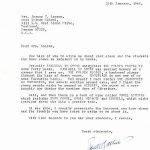According to a recent study, companies that are in the process of filling a position often call in just one or two people for an interview after reviewing up to 200 resumes. Moreover, these employers usually spend little time reviewing each resume, usually between 10 to 20 seconds. As a result, companies often determine who they will interview based on their first impression of a job seeker’s resume. This is one reason why it is so important to structure your resume so that key information will be seen. In many regards, job seekers should view their resume as an advertisement — an advertisement of themselves.
To prepare an eye-catching resume, job seekers must learn how to effectively market their job skills. For those who don’t have a background in marketing, this can be a challenging task. To develop an effective resume, job seekers must learn to market their skills and educational background as they would a commodity.
An effective resume does not require outlandish claims, exaggerated skills or superior work experience. However, jobseekers musn’t be overly humble either, since they do need to set themselves apart from the competition. Even job seekers lacking experience or skills can set themselves apart from better qualified applicants by effectively selling their skills through a strategically designed resume.
Focus On The Employers Needs
In many cases, managers responsible for hiring are also in charge of the division or department they’re hiring for. Often, their careers are linked to the productivity of the division they supervise and consequently the individuals they hire. Job seekers must develop resumes that quickly convince hiring managers and supervisors that they would add to a division’s productivity.
Job seekers who are not intimately familiar with a hiring company, the industry, or the position their applying for, need to take the time and make whatever effort necessary to seek out and network with other professionals in the industry and employees who work for the hiring company. It’s also beneficial to contact a company directly to find out what it’s looking for in prospective employees. Companies are more likely to schedule interviews with job seekers that are knowledgable, proactive and genuining interested in the working for them.
Start by Developing a Plan
Before preparing a resume, make sure you have determined what you want it to emphasize. This should be related directly to what the hiring company is seeking in prospective employees, as well as what the job description for the position you’re apply for. Relate your current job skills and experience to the skills and experience the hiring company requires.
If you are unsure of what skills you possess that could benefit a prospective employer, spend some time brainstorming. Ask yourself some of the following questions: What skills will enable me to contribute to a company’s (or division’s) productivity? What sets me apart from other people working in this industry? What is this company specifically seeking in employees? What do I bring to the table that other candidates don’t?
Individuals entering an industry for the first time, such as college graduates, or those in a mid-career transition, often have to be creative when indentifying what skills they possess that are directly applicable in the industry where they’re seeking employment.

Once this is done, it is important to select a resume style that effectively highlights job skills or prior work experience.
An Effective Resume Has Two Main Sections
The first section of your resume should highlight your qualifications, job skills, and personal accomplishments. Make sure your resume is appealing and compelling, so managers will spend some time reviewing it — but do not embellish achievements.
After you have detailed your skills in the first secion, you need to support your assertions in the second section by providing supporting evidence. You can provide information about previous work experience or your educational background the skills you’ve outlined.
In preparing these two sections, be careful not to inundate the resume with too much information. You want to provide just enough information to spark interest, so that a prospective employer will schedule an interview with you in order to learn more about your skills and qualifications.
It is not a bad idea to consider inserting a summary or objective statement in your resume. This statement is a short description of your current career goals. This is a particulary good idea for people in the middle of a career transition or for recent college graduates.
Resumes are intended to briefly summarize the background and skills a job seeker has to offer the prospective employer. Therefore, a resume should be very focused and succinct.
To help keep you resume focused, make sure to clearly communicate your career goals. If a prospective employer gets the impression that you are not really committed to pursuing a career in their industry, you will likely miss out on an interview opportunity.
One strategy that will help you clearly communicate your career goals is to have an objective statement in your resume. An objective statement is one sentence that describes your short and long-term career goals.
An objective statement can be extremely helpful to employers who receive large quantities of resumes. An objective statement can show them who is truly interested in a position and who is not.
The following is a generic example of an objective statement:
OBJECTIVE – Seeking employment in an entry-level position to learn the necessary skills to pursue a career in a (specific) industry.
Here’s how to write your objective. It’s a good idea to list a specific job in your objective statement. This will help you stand out and demonstrate your interest in the specific position a company is looking to fill.
Make sure your objective statement is clear and direct as possible. Do not try to impress employers with unique vocabulary or wordy phrases. Your resume will more than likely be glanced at for a few seconds, nothing more, so make the objective statement easy to read and to the point.
Jobseekers interested in various job opportunities should prepare separate resumes, each with unique objective statements reflecting the individual position. It is also useful to make minor changes in each resume to highlight specific skills or experience applicable to each job you’re applying to.
Occasionally, jobseekers incorporate their objective statement into summary section of the resume. This can work, if done effectively.
Individuals in the middle of a career transition, or those with little or no work experience, need to emphasize what skills they plan to acquire and develop in the future — and how they’re doing that. Job seekers with experience in the industry where they’re seeking new employment opportunities should emphasize their qualifications and accomplishments in that industry before anything else.
The Summary Statement
Many resume experts now believe that the career objective should be scrapped all together in favor of the Summary Statement. Where the career objective focuses on the goals, objectives and desires of the job seeker, the summary statement focuses on what the job seeker can provide the employer.
The summary statement should be located at the top of the resume, directly below the contact information. It should be no longer than a few sentences and should quickly highlight the skills and accomplishments of the job seeker that are directly relevant to the desired position.
The summary statement is like a sales pitch with a bite. It focuses on what the employer wants to know. Learn more about how to develop and implement a powerful summary statement by reading our article How to Write a Powerful Summary Statement .
The summary is a more traditional version of the summary statement. While useful, we recommend incorporating a summary statement into your resume, rather than the antequated summary. Below you can learn more about the summary, but if you decide to use a summary statement, your resume will not require a summary.
The summary section gives job seekers the opportunity to provide a brief statement detailing specific skills and previous job experience. The summary section should be used to present experience and skills to prospective employers that are relevant to the position being applied for. In other words, it provides an opportunity to present information about yourself that will interest potential employers and set you apart from the competition.
Similar to the objective statement, when developing the summary section, it is important to ask yourself what the companies you are interested in working for are seeking in employees. Once you have determined what an employer is are seeking, evaluate the skills and experience you possess an incorporate it into the summary.
The following are suggestions for information to include in the summary:
- A concise statement detailing previous job experience
- Information about individual expertise usually stated in broad terms
- Also include two or three subsequent details pertaining to: the extent of job skills, details about a distinctive combination of skills, details about different environments you have worked in, an achievement that is provable, and details about past achievements, recognitions, or promotions
- Information about one or numerous personal qualities applicable in a work setting
- A single sentence discussing your goals or objectives.
The following examples are intended to illustrate how to insert an objective statement within the summary. Individuals making a mid-career transition, or recent college graduates, should detail past achievements within the summary. This way, potential employers can gauge how they will perform if they are hired.
A few examples of Summary sections:
- Very skilled, innovative, and motivated engineer with six years of experience planning and supervising municipal infrastructure projects. Extensive experience supervising employees and working within groups. Superb organization and communication skills. Desiring a supervisor position with a civil engineering firm that will enhance personal management skills.
- More than 8 years of experience working as a management consultant providing consulting services to over 15 Fortune 500 Companies. A personal desire to assist companies seeking to improve management skills and efficiency. Self-motivated individual with superb communication, analytical, and organizational skills.
- Experienced defense attorney with more than 10 years of experience providing legal representation for individuals accused of committing criminal offenses. Skilled researcher with excellent communication and negotiation skills. DUI and fraud defense are areas of specialty.
Skills and Accomplishments
This section provides job seekers an opportunity to provide more information about job skills and experience. This section is similar to other sections, but here job seekers can provide more detailed statements about their qualifications.
In other sections of the resume, specialized job skills and experience are emphasized. However, in Skilles and Accomplishments section, special emphasis is placed on results that have been acheived. For example, if management skills were detailed in the summary, job seekers would show how their management skills led to increased productivity or other positive outcomes resulting from their management skills.
It is also recommended, as in other sections, not to flood this section with too many details. Again, the purpose of the resume is to get an interview. You want to leave enough unsaid so that potential employers will want to learn more about you and schedule an interview.
There is no single correct way to prepare the skills and accomplishment section of a resume. However, it is recommended to insert job skills and other vital information meant to be emphasized before less important details.
Here are a few recommendations for formatting your “Skills and Accomplishments” section:
1. Details about job skills and achievements set apart using bullet points
SELECTED SKILLS AND ACCOMPLISHMENTS
- Managed more than 20 employees in the human resources division.
- Collaborated with senior executives when revising new human resource policies.
- Organized training seminars and met individually with employees struggling with company policies.
2. Individual details listed under sub-headings about skills or achievements. This information can be listed under bullet points or written in individual paragraphs. Details should also be listed providing support for statements about skills and achievements.
Project manager responsible for supervising staff developing new personal use computer policy for company employees
Supervised employees within the human resource department as they revised the policy on personal computer usage among company employees. After the suggested changes were complete, was responsible to present and defend the new changes to senior management. Once the new policies were put into effect, employee efficiently increased by 25 percent.
3. Those preparing a chronological resume should list their achievements under a job title heading, outlining each achievement with a bullet point.
Example: Manger of Human Resources Department
Salt Lake Steel Corporation, Salt Lake City, UT
- Supervised 20 employees working within the human resources department at a large regional steel manufacturer. Responsible for instructing and training these employees to work directly with different divisions within the company. Also worked directly with senior management to determine new human resource policies.
- Recruited and interviewed prospective employees to work within the human resource division. Hired numerous individuals who were later promoted to management positions within the company.
- Met individually with employees with questions regarding company policies. Resolved a large dispute among employees within the shipping department.
- Oversaw the 10 million dollar budget set aside to provide employees with health insurance.
BASIC RESUME FORMATS
The three most common resumes are the functional, chronological, and combined resume, a resume mixing elements from both the functional and chronological resume together. You can learn more about each resume format below.
- Chronological Resume
- Functional Resume
- Combined Resume
As the name implies, a combined resume combines aspects of both functional and chronological resumes. It usually consists of job skill descriptions followed by details about former job responsibilities. Many combined resumes resemble functional resumes by placing job skills under headings detailing previous jobs.
These types of resumes are advantageous for job seekers wanting to utilize the positive aspects of both chronological and functional resumes. However, these resumes tend to be wordy and long. Importants details are sometimes stated repeatedly in combined resumes.






 Writing a good hypothesis worksheet for middle school
Writing a good hypothesis worksheet for middle school Writing if then hypothesis worksheet 2
Writing if then hypothesis worksheet 2 Fancy writing alphabet generator for myspace
Fancy writing alphabet generator for myspace Potterton netaheat 10-16 not igniting your writing
Potterton netaheat 10-16 not igniting your writing Yours faithfully in letter writing
Yours faithfully in letter writing






